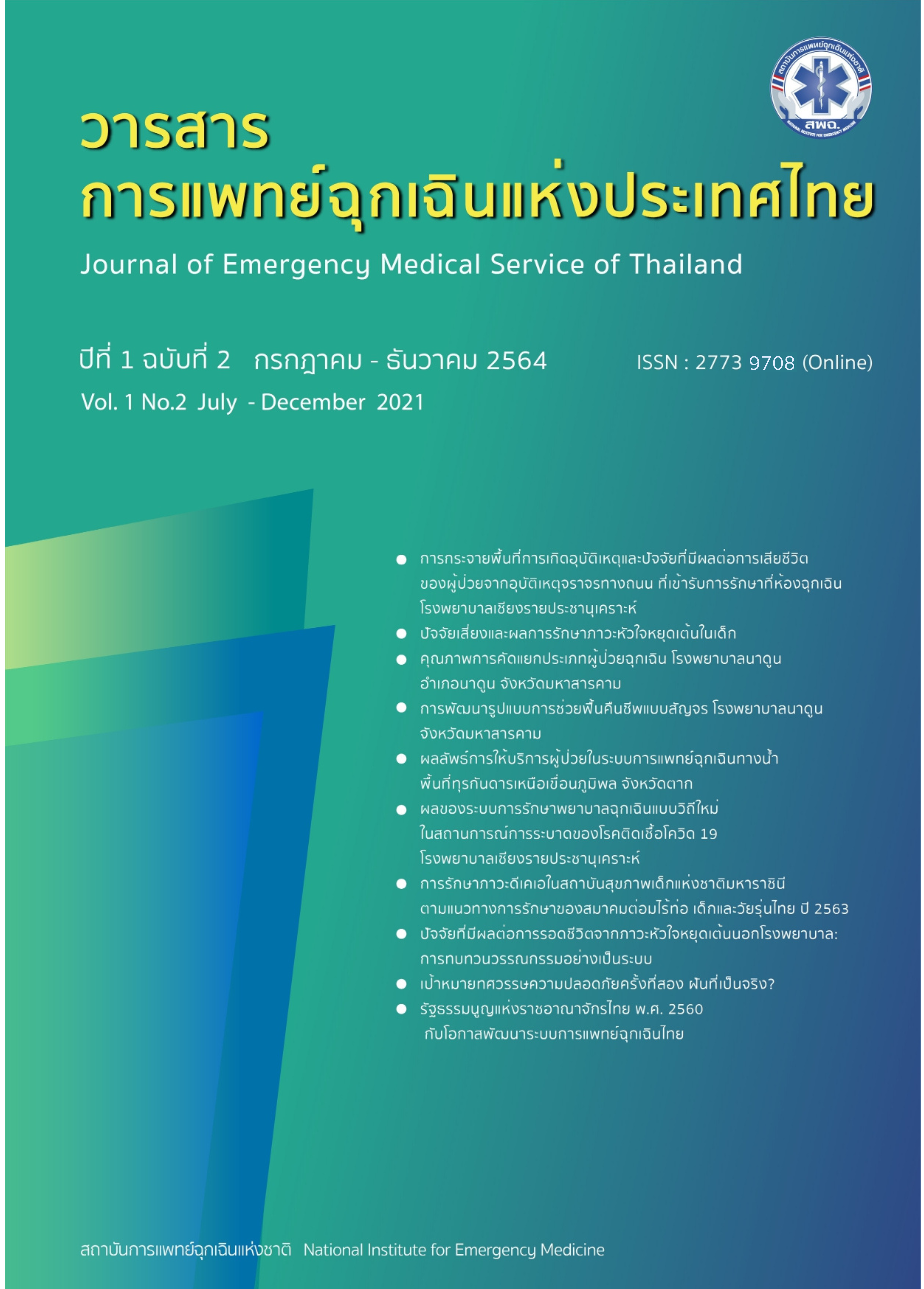ปัจจัยเสี่ยงและผลการรักษาภาวะหัวใจหยุดเต้นในเด็ก
DOI:
https://doi.org/10.14456/jemst.2021.12คำสำคัญ:
การฟื้นคืนชีพ, การช่วยฟื้นคืนชีพสำเร็จ, ภาวะพร่องออกซิเจน, หัวใจห้องล่างเต้นผิดจังหวะ, ภาวะหัวใจหยุดเต้นในโรงพยาบาลบทคัดย่อ
ภาวะหัวใจหยุดเต้นเป็นภาวะฉุกเฉินที่ต้องการการรักษาอย่างเร่งด่วน สาเหตุของการเกิดภาวะหัวใจหยุดเต้น มักเป็นผลที่ตามมาจากภาวะการหายใจล้มเหลว ช็อก หรืออาจเกิดร่วมกันได้ทั้งสองอย่าง เมื่อเกิดภาวะหัวใจหยุดเต้นถึงแม้ว่ารักษาอย่างเต็มที่ ผลการรักษามักจะไม่ดี ดังนั้น การเฝ้าระวัง การวินิจฉัยและการรักษาให้ทันท่วงทีจะทำให้รอดชีวิตได้มากขึ้น การศึกษานี้มีวัตถุประสงค์เพื่อทราบถึงอุบัติการณ์ ความเสี่ยง ชนิดคลื่นไฟฟ้าหัวใจ และผลของการรักษาภาวะหัวใจหยุดเต้นในสถาบันสุขภาพ-เด็กแห่งชาติมหาราชินี เป็นการวิจัยเชิงพรรณนาย้อนหลังของผู้ป่วยที่อายุระหว่าง 1 เดือน ถึง 15 ปี ที่มีภาวะหัวใจหยุดเต้นใน โรงพยาบาลและได้รับการฟื้นคืนชีพโดยใช้แนวทางการช่วยชีวิตผู้ป่วยเด็กปี ค.ศ. 2010 ของสมาคมแพทย์โรคหัวใจแห่งสหรัฐอเมริกา (AHA guideline 2010, Pediatric Advanced Life Support, PALS) ในสถาบันสุขภาพเด็กแห่งชาติมหาราชินี ตั้งแต่ 1 มกราคม 2555 ถึง 31 ธันวาคม 2559 การศึกษานี้มีผู้ป่วยเข้าร่วมทั้งหมดจำนวน 214 คน เป็นเพศชายต่อเพศหญิงเท่ากับ 1.1 ต่อ 1 อายุที่พบหัวใจหยุดเต้นมากที่สุดอยู่ระหว่าง 1 ถึง 4 ปี คิดเป็นร้อยละ 43 ผู้ป่วยมีโรคประจำตัวอยู่เดิมร้อยละ 74 โดยเฉพาะโรคทางระบบหัวใจพบมากที่สุด สถานที่ที่พบมากที่สุดคือ หอผู้ป่วยทั่วไปพบร้อยละ 78 ลักษณะคลื่นไฟฟ้าหัวใจแรกที่พบมากสุดเป็น asystole ร้อยละ 63 ส่วนหัวใจห้องล่างเต้นผิดจังหวะ ชนิด ventricular arrhythmias พบร้อยละ 17 สาเหตุของการเกิดหัวใจหยุด-เต้นในเด็กที่พบมากที่สุด คือ ภาวะพร่องออกซิเจน ผลของการรักษาคือ ช่วยฟื้นคืนชีพสำเร็จ ร้อยละ 46.7 เสียชีวิต ร้อยละ 53.3 และรอดชีวิตจนกลับบ้านร้อยละ 9.8 ปัจจัยเสี่ยงที่ทำให้มีผลต่อการเสียชีวิตอย่างมีนัยสำคัญทางสถิติคือ โรคหัวใจและหลอดเลือด สถานที่เกิดเหตุและลักษณะคลื่นไฟฟ้าหัวใจชนิด ventricular arrhythmias โดยสรุป การศึกษานี้พบว่าในผู้ป่วยที่มีภาวะหัวใจหยุดเต้น มีอัตราการรอดชีวิตจนกลับบ้านเพียงร้อยละ 10 ซึ่งพบว่าอัตราการเสียชีวิตมีความสัมพันธ์กับสถานที่เกิดเหตุ แต่เนื่องจาก หอผู้ป่วยวิกฤตของสถาบันสุขภาพเด็กแห่งชาติฯ มีจำนวนจำกัด ทำให้ผู้ป่วยที่มีความเสี่ยงต้องรับการรักษาที่หอผู้ป่วยทั่วไป ดังนั้น จึงควรพัฒนาการเฝ้าสังเกตและพัฒนาศักยภาพของบุคลากร รวมถึงเพิ่มจำนวนเตียงผู้ป่วยเพื่อให้เพียงพอต่อความต้องการเพื่อลดอัตราความเสี่ยงการเสียชีวิตในผู้ป่วยกลุ่มนี้
เอกสารอ้างอิง
Young KD, Seidel JS. Pediatric cardiopulmonary resuscitation:a collective review. Ann Emerg Med 1999;33:195–205.
Young KD, Gausche-Hill M, McClung CD, Lewis RJ. A prospective, population-based study of the epi- demiology and outcome of out-of-hospital pediatric cardiopulmonary arrest. Pediatrics 2004;114:157-64.
Kleinman ME, Chameides L, Schexnayder SM, Samson RA, Hazinski MF, Atkins DL, et al. Part 14: pediatric advanced life support: 2010 American Heart Association guidelines for cardiopulmonary resuscitation and emergency cardiovascular care. Circulation 2010; 122(suppl3):S876–S908.
Slonim AD, Patel KM, Ruttimann UE: Cardiopulmonary resuscitation in pediatric intensive care units. Crit Care Med 1997; 25:1951–5.
Reis AG, Nadkarni V, Perondi MB, Grisi S, Berg RA.A prospective investigation into the epidemiology of in-hospital pediatric cardiopulmonary resuscitation using the international Utstein reporting style. Pediatrics 2002; 109:200–9.
R de Caen A, Maconochie I, Aickin R, Atkins D, Biarent D, Guerguerian A, et al. Part 6: pediatric basic life support and pediatric advanced life support: 2015 International Consensus on Cardiopulmonary Resuscitation and Emergency Cardiovascular Care Science With Treatment
Recommendations (Reprint). Pediatrics 2015; 136(Supplement):88-119.
Nadkarni VM, Larkin GL, Peberdy MA, Carey SM, Kaye W, Mancini ME, et al. National Registry of Cardiopulmonary Resuscitation nvestigators. First documented rhythm and clinical outcome from in-hospital cardiac arrest among children and adults. JAMA 2006; 295:50–7.
Girotra S, Nallamothu B, Spertus J, Li Y, Krumholz H,Chan P. Trends in Survival After In-Hospital Cardiac Arrest. Survey of Anesthesiology 2013; 57(2):73-4.
de Mos N, van Litsenburg RR, McCrindle B, Bohn DJ, Parshuram CS. Pediatric in-intensive-care-unit cardiac arrest: incidence, survival, and predictive factors. Crit Care Med 2006; 34:1209–15.
Samson RA, Nadkarni VM, Meaney PA, Carey SM, Berg MD, Berg RA. American Heart Association National Registry of CPR Investigators. Outcomes of in-hospital ventricular fibrillation in children. N Engl J Med 2006; 354:2328–39.
Lambert V., Matthews A., MacDonell R., Fitzsimons J. Paediatric early warning systems for detecting and responding to clinical deterioration in children: a systematic review. Open BMJ 2017;7:1-13.
Brown SR, Garcia DM, Agulnik S. Scoping Review of Pediatric Early Warning Systems (PEWS) in ResourceLimited and Humanitarian Settings 2019;6:1-9.
Kukreti V., Gaiteiro R., Mohseni-Bod H. Implementation of a pediatric rapid response team: experience of the Hospital for Sick Children in Toronto. Indian Pediatrics 2014;51:11-5.
ดาวน์โหลด
เผยแพร่แล้ว
รูปแบบการอ้างอิง
ฉบับ
ประเภทบทความ
สัญญาอนุญาต
ลิขสิทธิ์ (c) 2021 สถาบันการแพทย์ฉุกเฉินแห่งชาติ

อนุญาตภายใต้เงื่อนไข Creative Commons Attribution-NonCommercial-NoDerivatives 4.0 International License.






